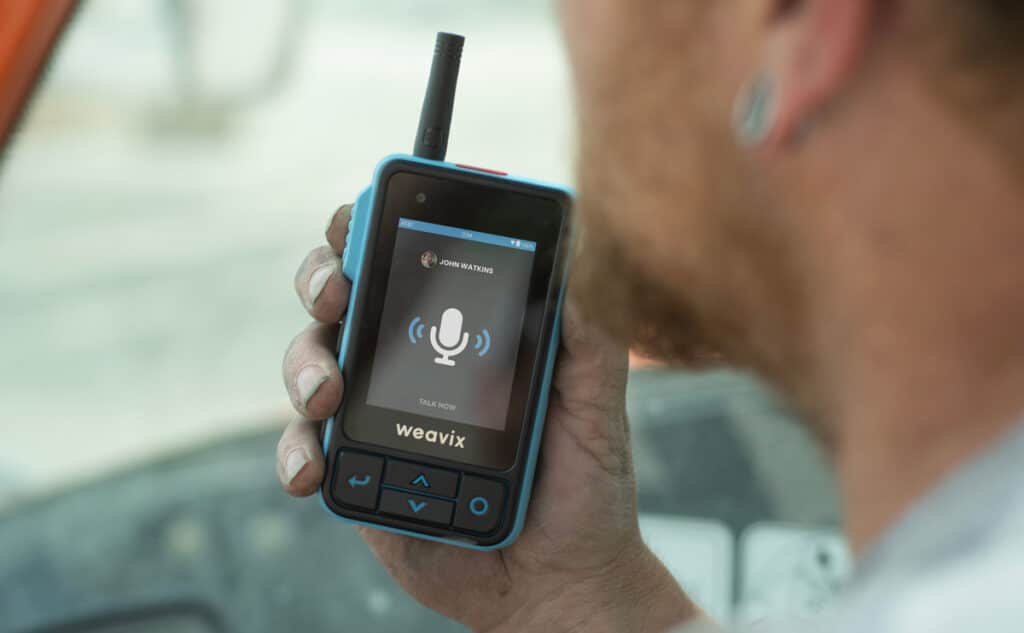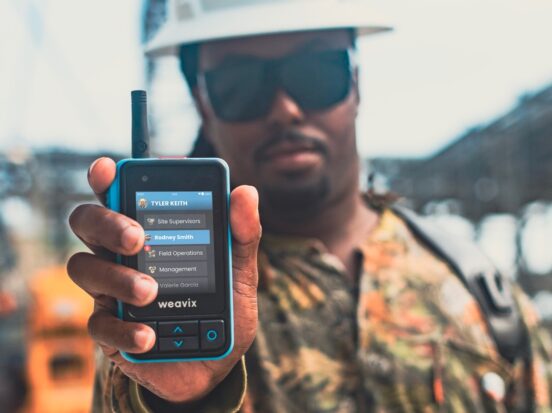Frontline workers built this country, but the frontline employee experience has left a lot to be desired. Research by BCG found that more than half of all frontline workers say they feel burned out. In these environments, it’s easy for workers to feel isolated without easy access to their peers. Yet for most of our nation’s history, manufacturing workers and employees in other industrial settings had no easy way to communicate with each other. The technology simply didn’t exist.
But now technological advances have created new opportunities for an improved experience on the frontline. Specifically, advances in smart radios ease communication and allow companies to get unique insights from their frontline employees. Think of today’s smart radios as an essential piece of your employee experience platform.
Key takeaways:
- Poor frontline employee experience has historically meant lower worker engagement and higher turnover, but technologies like smart radios are helping reverse this trend.
- Digital employee experience tools like smart radios remove communication barriers, improve frontline worker engagement, increase productivity, and enhance safety.
- Employee experience tools must connect every frontline worker with each other and company stakeholders to be effective.
- The Walt® Smart Radio System by weavix® can redefine the worker experience with a complete digital communication platform.
What Does Frontline Experience Mean?
Frontline experience means everything that affects your employees’ workflow every single day, from the communication solutions they use to the support and feedback they receive. Think about all the factors that either improve or inhibit your workers’ ability to get the job done:
- How workers communicate with you, each other, and any other supervisors at your company
- How many different languages your workers speak, and how easily they can understand each other (if at all)
- Your worksite safety plan, and how it protects workers from accidents
- How employees receive instructions and get help
- Employees’ access to tools and resources
And that’s just for starters. Any manufacturing plant manager, operations manager, or safety manager could add many more details about the specific situations their workers deal with every day. Employees face countless decisions that define their frontline work experience from the moment they begin their onboarding to everything that follows during every shift.
Read that again, and you’ll see the greatest obstacle to a better worker experience and the greatest opportunity for your team as a whole. Because while everyone on your team was hired to do a specific job, their ability to perform that job depends on far more than just their relevant skills. Your team’s success depends upon how well you can encourage frontline workforce collaboration. And the more freely your team can communicate, the better their experience will be.
Benefits of Frontline Employee Experience Tools
Why should you open up clear lanes of communication to improve frontline employee experience? MIT discovered companies that use real-time data to create a better experience for their employees and customers were more agile when faced with challenges and threats. MIT also found that top quartile companies had 97% higher profit margins and 62% higher revenue than the bottom quartile in their study. Yet as impressive as these numbers are, they’re simply the natural end result of superior workforce collaboration.

When a single worker has a great frontline experience, what does that look like?
- Improved collaboration and support: A single worker feels connected to all their coworkers. They know they can ask anyone for help – no matter what language they speak – just like anyone can ask them for help in return.
- Enhanced job performance and resource accessibility: A single worker knows how to perform their jobs, and they can easily access all the resources and information they require if they get stuck.
- Increased safety: A single worker feels safer, both physically and psychologically (they have the means and encouragement to speak up before something goes wrong).
- Greater frontline employee engagement: A single worker feels fully engaged with their work. They understand the company’s mission and they’re focused on each task at hand.
- Higher frontline workforce retention: A single worker is much less likely to consider leaving their work for a new job somewhere else.
For example, a survey by PwC found that 84% of respondents consider safety as the most impactful factor for creating a positive workplace for frontline employees. And SHRM found that employees who report high engagement and experience scores are 6x more likely to report high job satisfaction. Plus, 78% fewer employees will think of quitting companies that create a positive culture and a better worker experience.
Why Your Business Needs a Digital Employee Experience Platform
While it’s important to consider the experience of an individual employee, this is only a starting point for enterprise-wide collaboration. That’s because no one performs at their best in isolation. Whatever one employee experiences will ripple outward to affect everyone else in your company.
This ripple effect reveals the challenge and opportunity we mentioned earlier. Without the right digital employee experience tools, your workers won’t be able to communicate with you or each other, and their experience will begin to deteriorate.
If your workers don’t have the right communication solution, they won’t be able to access the information they need. And without an employee experience platform for the frontline, it will be that much more challenging to keep your team safe.
Better communication lies at the root of your frontline worker experience. The right tools will allow your team to communicate more clearly so you can create a network of accountability.
How to Improve Employee Experience on the Frontline with Smart Radios
As we say at weavix, a smart radio combines the soul of a legacy radio with the brains of a smartphone for a better frontline worker experience. Walt is simply the best of both worlds. Devices like the Walt Smart Radio System by weavix connect everyone on the frontline with push-to-talk (PTT) capabilities just like two-way analog radios, but the similarities end there.
Walt offers a complete digital communication platform that can connect all your frontline workers with supervisors and your leadership team:
| Walt Smart Radio System Capabilities | How These Functions Improve The Frontline Employee Experience |
|---|---|
Communication solutions on LTE and Wi-Fi, so you can avoid costly FCC licensing | Create as many channels as you need to connect all your frontline workers in real-time |
| Your employees can provide additional context to any message for quicker issue resolution | |
| Remove workplace communication barriers so everyone can work together as a unified team on the frontline | |
| Quickly notify everyone in case of an emergency, no matter where they’re located on-site | |
| Every incoming message is dictated by AI, so your employees can listen to messages whenever it’s safe so they never miss a thing | |
| Encourage productivity, well-being, and other benefits of music at work with safety-compliant music |
Why You Can’t Rely on Legacy Radios as Employee Experience Platforms
No legacy radio could cut it as an employee experience tool, since most of these devices are strictly one-dimensional. If all you have is PTT communication, what happens when employees move out of range? If your team only has one mode of communication, what happens when that channel breaks down?

How do you use real-time data to create a better frontline employee experience? Recall the MIT study that saw massive jumps in revenue and profit margins thanks in part to improvements in employee experience. If you want to apply this concept to smart radios, then these gains are only possible if everyone has a device.
But ironically, many legacy two-way radio systems like those at Motorola have been pushing you in the opposite direction:
- With a hefty price tag on top of FCC licensing for each channel, legacy radios have a very high total cost of ownership (TCO). So, companies could only justify giving radios to a small percentage of their frontline workforce.
- Worse, because many legacy radio companies have adopted tiered business models with multiple levels of distributors, replacements can take weeks or months to show up.
- These pricing concerns — along with their one-dimensional communication model — suggest that legacy radios have been degrading frontline worker experience for decades.
How Walt Reverses This Bad Worker Experience Trend
The Walt Smart Radio System gives your team new options to communicate based on their preferences and use cases. They will have many new and more natural ways to communicate, which means you have many more ways to improve employee experience.
Walt enables your connected workers to stay in touch in any situation. And that means they’ll be more engaged with their work and less likely to leave. Most importantly, you’ll be able to preserve a record of all worksite communication and track real-time activity across the platform.
Since we only sell our Walt Smart Radio System directly, you don’t have to pay different distributors’ margins on top of the cost of the device. And since Walt runs on LTE and Wi-Fi, you don’t need to invest in radio infrastructure or FCC licensing. Both of these factors significantly lower your TCO. As an example, compare Walt with two of the typical, legacy radio offerings from Motorola.
Walt Smart Radio vs. Motorola R5 and MOTOTRBO Key Takeaways
- Walt Smart Radio offers unlimited range, multi-modal communication (voice/text/video), and built-in AI translation services for 20+ languages. Walt gives you the ability to track productivity metrics of your workforce and send man-down and mass safety alerts at the push of a button, all at a much lower TCO than legacy two-way radios.
- Motorola R5 is a traditional radio with solid audio quality and some basic digital features, but it requires significant manual management, FCC licensing, and infrastructure, all of which drive up costs.
- Motorola MOTOTRBO is a family of legacy radios that requires costly, ongoing investments in hardware, FCC licensing, infrastructure, maintenance, and upgrades.
Walt Smart Radio vs. Motorola R5 and MOTOTRBO Comparison
| Category | Walt Smart Radio | Motorola R5 | Motorola MOTOTRBO |
|---|---|---|---|
| Form Factor | Rugged, compact smart radio with touchscreen + cameras | Rugged, compact; optional display/keypad | Traditional radio form factor |
| Audio Quality | 110 dB with AI noise suppression | Up to 106 dB with AI suppression | Variable; depends on model and signal strength |
| Display | 2.25” full-color touchscreen | 1.5” monochrome screen (if equipped) | Limited display unless using expensive models |
| Battery Life | 16-18 hours (depends on usage) | 20-22 hrs (standard), up to 30-32 hrs (high-capacity) | Varies; replacement batteries often needed |
| Communication Type | Voice, Text, Photo, Video (PT3) | Analog + DMR digital Push-to-Talk | Primarily voice, limited text (Wave PTX optional) |
| Range | Unlimited (via LTE/Wi-Fi) | 1-5 miles LOS; extended with repeaters | Limited to repeater coverage |
| Connectivity | Wi-Fi (2.4/5 GHz), LTE (public/private), Bluetooth, GPS, NFC | UHF/VHF, Wi-Fi, Bluetooth 5.2 | Repeater dependent; some Wi-Fi/Bluetooth support |
| Channel Management | Unlimited, cloud-managed | Up to 256 channels, 50 zones | Fixed channels; admin programming required |
| Translation Support | Built-in real-time AI translation (20+ languages) | Not available | None; requires human translators |
| Location Services | GPS, BLE, real-time proximity sensing | GPS (optional); integration needed | Limited unless subscribed to extra services |
| Safety Features | Emergency button, Man-Down, Lone Worker | Emergency button; Lone Worker optional | Emergency button, alerts (limited without add-ons) |
| Durability | IP68 waterproof, Class 1 Div 2, rugged | IP67, MIL-STD 810H, IS model available | Durable but model-dependent |
| Licensing Requirements | No FCC license needed | FCC license required (additional cost) | FCC license per frequency/site required |
| Operating System | waltOS (proprietary) | N/A | N/A |
| Software/Firmware | Centralized cloud dashboard, real-time OTA updates | Wi-Fi OTA basic programming | Manual technician updates, no cloud-native features |
| Data and Analytics | Full frontline data analytics | Basic messaging only | No analytics unless combined with other systems |
| Cost Model | Subscription ($35/month includes device, service, warranty) | $650-$800 hardware only + service | Very high TCO: hardware, licensing, service, infrastructure |
| Total Cost of Ownership (TCO) | Lowest; simple and predictable | High; licensing and add-ons raise costs | Up to 10x higher TCO than Walt |
| Cloud Integration | Full native cloud platform | None | None; legacy on-premise systems |
| Warranty | weCare™ - full warranty with coverage for accidental damage | 2 years standard, optional extended | Optional extended service at high cost |
With our weCare program, if any of your Walt Smart Radios gets damaged we can ship a free replacement in a few short days. Just tell us and we’ll send you a new unit along with a prepaid mailer so we can inspect the broken device for possible upgrades. You shouldn’t have to wait weeks or months for a replacement from Motorola. Our primary goal is to make sure you and your team always have the best smart radios to create a better frontline employee experience.
Give Your Workers the Best Employee Experience Platform with weavix
Gartner found that when you shift the focus from technology to your workers, you’ll have a much clearer path to improve the frontline employee experience. Because one of the best ways to improve experience is to make sure all your workers can easily communicate with anyone else on your team, at any time. And that’s only possible if everyone has a smart radio and the lead time on replacements shrinks from months to just a few days.
Walt improves communication, collaboration, and safety, and in doing so heightens frontline worker experience. When everyone on your team has a Walt, they’ll be able to communicate much more easily and stay safe in their day-to-day tasks. And that will make your company a much better place for your frontline employees and everyone they serve.
The Walt Smart Radio System gives your employees the tools they need so they can do their best work. Request a demo with us today.
 Andrew Rhodes
Andrew Rhodes 
